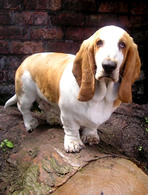
The Basset Hound is easily recognizable with its loose, folding skin, elongated
ears, cheerless brown eyes, prominent dewlap, and shortened, crooked legs.
It has a long body, a big muzzle, and a dense coat that shields it from thorny
shrubs. It is a direct descendant of the Bloodhound, which explains the facial
resemblance between the two breeds. The Basset hound first gained popularity
when it was entered as participant in a dog show in Paris in the 1860s.
Life Expectancy:
9-11 years
Energy Level:
Calm and affectionatebut stubborn..
Living Conditions:
Apartment life is fine. Dog is very idle indoors. Needs outdoor exercise.
Barking:
Barks loudly when tracking.
Exercise Needs:
Moderate daily walks.
Breed Group:
Hound
Size:
Medium
Height:
11 to 15 inches
Weight:
45 to 65 pounds
Standard Hair Colors:
Variety of color. White with sand or chestnut color markings is common.
National breed club:
Basset Hound Club of America
Ancestors of the Bassett hound may have been used as a hunting aid since the 1500s, to hunters who set out on foot. Hares and rabbits were the specialty then, though these dogs were able to hunt any mammal. The Bassett’s slow movement is more of an advantage than a hindrance; the dog is able to lead its master to the quarry without startling it, thus making it an easier kill. Nowadays, it is still used for trailing hare, rabbit, fox, pheasant, and opossum, individually or in packs. It is also known to do well in basset field trials.
This is a friendly, calm, and lovable dog, often able to live harmoniously with children, other dogs and pets. It tends to snuffle scents and follow, though at a slow pace. It barks loudly when keyed up on trail, and tends to stay on trail until it’s lost. It enjoys performing tricks in exchange for food, though it moves slowly and does not bite. The Basset hound can get stubborn, and be difficult to housebreak, whereas it is often extremely affectionate toward its owner.
Letting it play in the yard or taking it out for a daily walk meets this breed’s exercise needs. More exercise is preferable, although milder forms of exercise can prevent excessive strain on the Basset’s front legs.
Though the Basset hound will take an opportunity to run and play outside, it tends to be idle inside, which makes it amenable to apartment life. Extended periods of time outdoors can keep this dog happy and fit.
A few minutes with a hard bristle brush is enough combing for the Basset’s coat. Shampooing should be given only as needed, while the area underneath the ears should be wiped weekly, and the toenails habitually trimmed.
The Bassett hound’s legs and back may in time be weakened by the weight of its long body, and lameness, even paralysis, is possible. Hip dysplasia is common. It should also be kept on a lean diet to prevent bloating and any weight gain that may increase the strain on its legs and spine. Eye ailments and foot infections have also been observed in this breed.
The fun-loving and easygoing nature of the Bassett hound, as well as its superb sense of smell, can also be found in the Otterhound, a larger and hairier breed that is more suitable for temperate to cooler climates.

Copyright © 2005-2016 Pet Information All Rights Reserved
Contact us: www162date@outlook.com